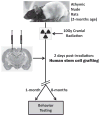Long-term cognitive effects of human stem cell transplantation in the irradiated brain
- PMID: 24882389
- PMCID: PMC5027837
- DOI: 10.3109/09553002.2014.927934
Long-term cognitive effects of human stem cell transplantation in the irradiated brain
Abstract
Purpose: Radiotherapy remains a primary treatment modality for the majority of central nervous system tumors, but frequently leads to debilitating cognitive dysfunction. Given the absence of satisfactory solutions to this serious problem, we have used human stem cell therapies to ameliorate radiation-induced cognitive impairment. Here, past studies have been extended to determine whether engrafted cells provide even longer-term benefits to cognition.
Materials and methods: Athymic nude rats were cranially irradiated (10 Gy) and subjected to intrahippocampal transplantation surgery 2 days later. Human embryonic stem cells (hESC) or human neural stem cells (hNSC) were transplanted, and animals were subjected to cognitive testing on a novel place recognition task 8 months later.
Results: Grafting of hNSC was found to provide long lasting cognitive benefits over an 8-month post-irradiation interval. At this protracted time, hNSC grafting improved behavioral performance on a novel place recognition task compared to irradiated animals not receiving stem cells. Engrafted hESC previously shown to be beneficial following a similar task, 1 and 4 months after irradiation, were not found to provide cognitive benefits at 8 months.
Conclusions: Our findings suggest that hNSC transplantation promotes the long-term recovery of the irradiated brain, where intrahippocampal stem cell grafting helps to preserve cognitive function.
Keywords: Human stem cells; cognition; hippocampus; radiation; transplantation.
Conflict of interest statement
Declaration of interest The authors report no conflicts of interest. The authors alone are responsible for the content and writing of the paper. This work was supported by the NIH-NINDS R01 NS074388581 (C.L.L.) and the California Institute for Regenerative Medicine (CIRM) training grant TG-01152 (M.M.A.).
Figures



Similar articles
-
Human neural stem cell transplantation provides long-term restoration of neuronal plasticity in the irradiated hippocampus.Cell Transplant. 2015;24(4):691-702. doi: 10.3727/096368914X684600. Epub 2014 Oct 6. Cell Transplant. 2015. PMID: 25289634 Free PMC article.
-
Comparing the functional consequences of human stem cell transplantation in the irradiated rat brain.Cell Transplant. 2013;22(1):55-64. doi: 10.3727/096368912X640565. Epub 2012 Apr 26. Cell Transplant. 2013. PMID: 22546529 Free PMC article.
-
Transplantation of human fetal-derived neural stem cells improves cognitive function following cranial irradiation.Cell Transplant. 2014;23(10):1255-66. doi: 10.3727/096368913X670200. Epub 2013 Jul 17. Cell Transplant. 2014. PMID: 23866792 Free PMC article.
-
Radiation injury and neurogenesis.Curr Opin Neurol. 2003 Apr;16(2):129-34. doi: 10.1097/01.wco.0000063772.81810.b7. Curr Opin Neurol. 2003. PMID: 12644738 Review.
-
Long-term effects of radiation therapy on cognitive and endocrine function in children with leukemia and brain tumors.Neurologist. 2004 Nov;10(6):293-310. doi: 10.1097/01.nrl.0000144287.35993.96. Neurologist. 2004. PMID: 15518596 Review.
Cited by
-
Exposure to Ionizing Radiation Causes Endoplasmic Reticulum Stress in the Mouse Hippocampus.Radiat Res. 2018 Nov;190(5):483-493. doi: 10.1667/RR15061.1. Epub 2018 Aug 7. Radiat Res. 2018. PMID: 30084740 Free PMC article.
-
Human neural stem cell transplantation provides long-term restoration of neuronal plasticity in the irradiated hippocampus.Cell Transplant. 2015;24(4):691-702. doi: 10.3727/096368914X684600. Epub 2014 Oct 6. Cell Transplant. 2015. PMID: 25289634 Free PMC article.
-
Elimination of microglia improves cognitive function following cranial irradiation.Sci Rep. 2016 Aug 12;6:31545. doi: 10.1038/srep31545. Sci Rep. 2016. PMID: 27516055 Free PMC article.
-
Cranial grafting of stem cell-derived microvesicles improves cognition and reduces neuropathology in the irradiated brain.Proc Natl Acad Sci U S A. 2016 Apr 26;113(17):4836-41. doi: 10.1073/pnas.1521668113. Epub 2016 Apr 4. Proc Natl Acad Sci U S A. 2016. PMID: 27044087 Free PMC article.
-
Functional equivalence of stem cell and stem cell-derived extracellular vesicle transplantation to repair the irradiated brain.Stem Cells Transl Med. 2020 Jan;9(1):93-105. doi: 10.1002/sctm.18-0227. Epub 2019 Sep 30. Stem Cells Transl Med. 2020. PMID: 31568685 Free PMC article.
References
Publication types
MeSH terms
Grants and funding
LinkOut - more resources
Full Text Sources
Other Literature Sources
Medical
Miscellaneous
